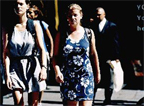February 21, 2007
Mapping the City

flâneur + dérive
Mapping the City :: 16 February – 20 May 2007 :: Stedelijk Museum CS, Post CS Building, 2nd floor, Oosterdokskade 5, 1011 AD Amsterdam, NL :: Tel. +31 (0)20 5732.911 :: Participating artists: Doug Aitken, Francis Alÿs, Stanley Brouwn, Matthew Buckingham, Philip Lorca diCorcia, Guy Debord/Asger Jorn, Ed van der Elsken, Valie Export, Lee Friedlander, Dan Graham, Frank Hesse, Douglas Huebler, William Klein, Saul Leiter, Sol LeWitt, Sarah Morris, Bill Owens, Martha Rosler, Ed Ruscha, Willem de Ridder en Wim T. Schippers, Beat Streuli, Jeff Wall.
‘Mapping the City’ focuses on the relationship between artists and the city from around 1960 to the present day. The group show revolves around the way in which artists perceive urban space. The emphasis is on the city as social community, on behaviour, poses, and urban rituals.
Two ideas are at the heart of the exhibition: the flâneur, a type first described by Charles Baudelaire around 1850, and the activity of dérive, a practice coined by Situationist Guy Debord. The exhibition begins in the late nineteen-fifties when Debord published his Theorie de la dérive (1958). Another jumping-off point is Stanley Brouwn’s famous series This way Brouwn. Starting in 1962, Brouwn started asking random passers-by for directions in getting from point A to point B. He gave each route that people drew for him the title This way Brouwn.
From the late nineteen-sixties and early nineteen-seventies onwards, many artists adopted the city as their workspace. Similar to Brouwn, themes such as walking through the city, chance, and grappling with our everyday environment are also integral to the work of Douglas Huebler. Others, like Martha Rosler, subject the metropolis to critical scrutiny. In her piece The Bowery in Two Inadequate Descriptive Systems Rosler employs photography and text to analyze the underbelly of New York society. For Austrian artist VALIE EXPORT, the city was ‘still a male space’. With her Tapp- and Touch Cinema (1968), she invited the viewer to a 'tactile experience that is the reverse of inauthentic voyeurism'.
Another theme in the exhibition is ‘street photography’. From the nineteen-fifties onwards, photographers like Ed van der Elsken, William Klein and Saul Leiter, injected post-war photography with a freshness and immediacy. For instance, Klein’s unpolished, experimental style caused quite a furore and inspired a generation of young photographers. His photo diary of New York figured people, children, parades, litter and an aggressive, alien, lonely urban landscape cluttered with raucous billboards.
Contemporary art
The core of Francis Alÿs' activities revolves around the many walks he has taken through the centre of Mexico City since the early nineteen-nineties. Alÿs’ Collection of Ephemera includes numerous drawings, photos, notes, maps and objects that relate to his walks in the ten-block radius around his studio in the historic centre of Mexico City.
The Heads of Philip Lorca diCorcia and the street scenes by Beat Streuli can be seen as contemporary variants of classic street photography. Their photographs capture the manifestly vacant expressions on the faces of anonymous passers-by.
A biography of Florida’s sun-drenched capital, Sarah Morris’ video work Miami presents the city’s various facets as the hub of the tourist industry, drug and illegal immigrant trafficking on a more or less equal footing. The film installation A Man of the Crowd by Matthew Buckingham is based on the similarly-titled short story by Edgar Allan Poe. The result is a tense mini-thriller set in the streets of Vienna. The video piece by Doug Aitken, Electric Earth, is pervaded by a powerful sense of estrangement. This overwhelming video installation projected onto eight huge screens confronts us with the modern city as though it were the remains of an alien civilization.
Posted by jo at February 21, 2007 10:48 AM
